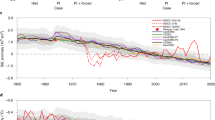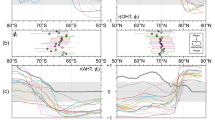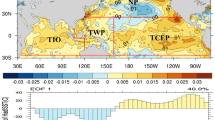Abstract
The last glacial maximum was marked by maximum land ice extent and lowest greenhouse gases concentration during the last ice age. We explore the impact of glacial continental ice sheet topography on the large-scale tropical ocean–atmosphere climate, in particular the tropical Pacific, in an intermediate complexity coupled model. Increasing the thickness of continental ice sheets causes a southward displaced Pacific Intertropical Convergence Zone (ITCZ) and a strengthening (weakening) of northern (southern) hemisphere winter Hadley cell. The equatorial zonal sea surface temperature gradient weakened with an increased continental ice sheets thickness, the reduction being caused by cooling in the western equatorial Pacific and warming in the eastern equatorial Pacific. The evolution of the tropical climate with changing ice thickness has distinct quasi-linear and nonlinear parts. While the linear part is a direct response to the ice topographic changes, the nonlinear part was a result of the tropical thermocline adjustment. Our analysis of a fully-coupled transient deglacial simulation strongly indicates the dominant role of ice sheet topography in determining the deglacial evolution of the simulated Pacific climate. The thickness of continental ice sheet, separate from ice albedo effect, has significant impact on the tropical ocean–atmosphere climate in particular with the meridional displacement in the Pacific ITCZ. The altered circulation states seen in the model may aid understanding of the relationship between tropical and high-latitude climate records in glacial-interglacial cycles.












Similar content being viewed by others
Notes
As with popular convention, we will use ‘El Nino-like’ and ‘La Nina-like’ to indicate equatorial zonal SST gradient states that resembles the present-day analog. We make no assumptions here as to their underlying dynamics.
References
Andreasen DJ, Ravelo AC (1997) Tropical Pacific Ocean thermocline depth reconstructions for the last glacial maximum. Paleoceanography 12(3):395–413
Broccoli AJ, Dahl KA, Stouffer RJ (2006) Response of the Itcz to northern hemisphere cooling. Geophys Res Lett 33:1
Chang P (1994) A study of the seasonal cycle of sea-surface temperature in the tropical Pacific-Ocean using reduced gravity models. J Geophys Res Oceans 99(C4):7725–7741
Chiang JCH, Bitz CM (2005) Influence of high latitude ice cover on the marine intertropical convergence zone. Clim Dyn 25(5):477–496
Chiang JCH, Friedman AR (2012) Extratropical cooling, interhemispheric thermal gradients, and tropical climate change. Annu Rev Earth Planet Sci 40:383–412
Chiang JCH, Biasutti M, Battisti DS (2003) Sensitivity of the Atlantic intertropical convergence zone to last glacial maximum boundary conditions. Paleoceanography 18(4):1094. doi:10.1029/2003PA000916
Chiang JCH, Fang Y, Chang P (2008) Interhemispheric thermal gradient and tropical Pacific climate. Geophys Res Lett 35:L14704. doi:10.1029/2008GL034166
Chiang JCH, Fang Y, Chang P (2009) Pacific climate change and endo activity in the mid-holocene. J Clim 22(4):923–939
Climap (1981) Climap 18 k Database, NOAA Paleoclimatology
Crowley TJ (2000) Climap Ssts re-revisited. Clim Dyn 16(4):241–255
Cvijanovic I, Chiang JCH (2013) Global energy budget changes to high latitude north Atlantic cooling and the tropical Itcz response. Clim Dyn 40:1435–1452
Dahl K, Broccoli A, Stouffer R (2005) Assessing the role of north Atlantic freshwater forcing in millennial scale climate variability: a tropical Atlantic perspective. Clim Dyn 24(4):325–346
Dekens PS, Lea DW, Pak DK, Spero HJ (2002) Core top calibration of Mg/Ca in tropical foraminifera: refining paleotemperature estimation. Geochem Geophy Geosys 3:1022. doi:10.1029/2001GC000200
Donohoe A, Marshall J, Ferreira D, Mcgee D (2013) The relationship between ITCZ location and cross-equatorial atmospheric heat transport: from the seasonal cycle to the last glacial maximum. J Clim 26:3597–3618
Herbert TD, Schuffert JD, Andreasen D, Heusser L, Lyle M, Mix A, Ravelo AC, Stott LD, Herguera JC (2001) Collapse of the California current during glacial maxima linked to climate change on land. Science 293(5527):71–76
Hewitt CD, Stouffer RJ, Broccoli AJ, Mitchell JFB, Valdes PJ (2003) The effect of ocean dynamics in a coupled Gcm Simulation of the last glacial maximum. Clim Dyn 20(2–3):203–218
Kang SM, Held IM, Frierson DMW, Zhao M (2008) The response of the Itcz to extratropical thermal forcing: idealized slab-ocean experiments with a Gcm. J Clim 21(14):3521–3532
Kang SM, Frierson DMW, Held IM (2009) The tropical response to extratropical thermal forcing in an idealized Gcm: the importance of radiative feedbacks and convective parameterization. J Atmos Sci 66(9):2812–2827
Kiehl JT, Hack JJ, Bonan GB, Boville BA, Williamson DL, Rasch PJ (1998) The national center for atmospheric research community climate model: ccm3. J Clim 11(6):1131–1149
Kim JH, Schneider RR (2003) Low-latitude control of interhemispheric sea-surface temperature contrast in the tropical Atlantic over the past 21 Kyears: the possible role of se trade winds. Clim Dyn 21(3–4):337–347
Kim SJ, Flato GM, Boer GJ (2003) A coupled climate model simulation of the last glacial maximum, part 2: approach to equilibrium. Clim Dyn 20(6):635–661
Koutavas A, Joanides S (2012) El Niño-Southern Oscillation Extrema in the Holocene and last glacial maximum. Paleoceanography 27:PA4208. doi:10.1029/2012PA002378
Koutavas A, Lynch-Stieglitz J (2003) Glacial-interglacial dynamics of the eastern equatorial pacific cold tongue-intertropical convergence zone system reconstructed from oxygen isotope records. Paleoceanography 18(4):131–1316
Koutavas A, Lynch-Stieglitz J, Marchitto TM, Sachs JP (2002) El Niño-like pattern in ice age tropical pacific sea surface temperature. Science 297(5579):226–230
Lea DW, Pak DK, Spero HJ (2000) Climate impact of late quaternary equatorial pacific sea surface temperature variations. Science 289(5485):1719–1724
Lee SY, Poulsen CJ (2005) Tropical pacific climate response to obliquity forcing in the pleistocene. Paleoceanography 20:4
Lee SY, Poulsen CJ (2006) Sea ice control of plio-pleistocene tropical pacific climate evolution. Earth Planet Sci Lett 248(1–2):253–262
Leech PJ, Lynch-Stieglitz J, Zhang R (2013) Western pacific thermocline structure and the pacific marine intertropical convergence zone during the last glacial maximum. Earth Planet Sci Lett 363:133–143
Li C, Battisti DS (2008) Reduced Atlantic storminess during last glacial maximum: evidence from a coupled climate model. J Clim 21(14):3561–3579
Liu Z, Otto-Bliesner BL, He F, Brady EC, Tomas R, Clark PU, Carlson AE, Lynch-Stieglitz J, Curry W, Brook E, Erickson D, Jacob R, Kutzbach J, Cheng J (2009) Transient simulation of last deglaciation with a new mechanism for bolling-allerod warming. Science 325(5938):310–314
Lunt DJ, Williamson MS, Valdes PJ, Lenton TM, Marsh R (2006) Comparing transient, accelerated, and equilibrium simulations of the last 30,000 years with the genie-1 model. Clim Past 2(2):221–235
Martinez I, Keigwin L, Barrows TT (2003) Yusuke yokoyama and john southon. La nina-like conditions in the eastern equatorial pacific and a stronger choco jet in the northern Andes during the last glaciation. Paleoceanography 18(2):111–181
Members, Climap Project (1976) Lgm climap sea surface temperature. Pangaea
Monnin E, Indermuhle A, Dallenbach A, Fluckiger J, Stauffer B, Stocker TF, Raynaud D, Barnola JM (2001) Atmospheric Co2 concentrations over the last glacial termination. Science 291(5501):112–114
North GR, Bell TL, Cahalan RF, Moeng FJ (1982) Sampling errors in the estimation of empirical orthogonal functions. Mon Weather Rev 110(7):699–706
Otto-Bliesner BL, Brady EC, Shin SI, Liu ZY, Shields C (2003) Modeling El Nino and its tropical teleconnections during the last glacial-interglacial cycle. Geophys Res Lett 30:23
Peltier WR (2004) Global glacial isostasy and the surface of the ice-age earth: the ice-5 g (Vm2) model and grace. Annu Rev Earth Planet Sci 32:111–149
Peltier WR, Solheim LP (2004) The climate of the earth at last glacial maximum: statistical equilibrium state and a mode of internal variability. Quatern Sci Rev 23(3–4):335–357
Quadrelli R, Bretherton CS, Wallace JM (2005) On sampling errors in empirical orthogonal functions. J Clim 18(17):3704–3710
Roe GH, Lindzen RS (2001) A one-dimensional model for the interaction between continental-scale ice sheets and atmospheric stationary waves. Clim Dyn 17(5–6):479–487
Rosenthal Y, Oppo DW, Linsley BK (2003) The amplitude and phasing of climate change during the last deglaciation in the Sulu Sea Western Equatorial Pacific. Geophys Res Lett 30:8
Russell JM, Vogel H, Konecky BL, Bijaksana S, Huang Y, Melles M, Wattrus N, Costa K, King JW (2014) Glacial forcing of central Indonesian hydroclimate since 60,000 y B.P. PNAS 111(14):5100–5105
Schmidt MW, Spero HJ (2011) Meridional shifts in the marine Itcz and the tropical hydrologic cycle over the last three glacial cycles. Paleoceanography 26:PA1206. doi:10.1029/2010PA001976
Schneider EK, Lindzen RS, Kirtman BP (1997) A tropical influence on global climate. J Atmos Sci 54(10):1349–1358
Shin SI, Liu Z, Otto-Bliesner B, Brady EC, Kutzbach JE, Harrison SP (2003) A simulation of the last glacial maximum climate using the Ncar-Ccsm. Clim Dyn 20(2–3):127–151
Stott L, Poulsen C, Lund S, Thunell R (2002) Super enso and global climate oscillations at millennial time scales. Science 297(5579):222–226
Stouffer RJ, Broccoli AJ, Delworth TL, Dixon KW, Gudgel R, Held I, Hemler R, Knutson T, Lee HC, Schwarzkopf MD, Soden B, Spelman MJ, Winton M, Zeng F (2006) Gfdl’s Cm2 global coupled climate models. Part IV: idealized climate response. J Clim 19(5):723–740
Timmermann A, Okumura Y, An SI, Clement A, Dong B, Guilyardi E, Hu A, Jungclaus JH, Renold M, Stocker TF, Stouffer RJ, Sutton R, Xie SP, Yin J (2007) The influence of a weakening of the Atlantic meridional overturning circulation on enso. J Clim 20(19):4899–4919
Trenberth KE, Caron JM (2001) Estimates of meridional atmosphere and ocean heat transports. J Clim 14(16):3433–3443
Wilks DS (2006) On “field significance” and the false discovery rate. J Appl Meteorol Climatol 45(9):1181–1189
Xie SP (1999) A dynamic ocean-atmosphere model of the tropical Atlantic decadal variability. J Clim 12(1):64–70
Yoshimori M, Broccoli AJ (2008) Equilibrium response of an atmosphere-mixed layer ocean model to different radiative forcing agents: global and zonal mean response. J Clim 21(17):4399–4423
Yoshimori M, Broccoli AJ (2009) On the link between Hadley circulation changes and radiative feedback processes. Geophys Res Lett 36:L20703. doi:10.1029/2009GL040488
Zheng W, Braconnot P, Guilyardi E, Merkel U, Yu Y (2008) Enso at 6 and 21 ka from ocean–atmosphere coupled model simulations. Clim Dyn 30(7–8):745–762
Acknowledgments
We greatly appreciate useful discussions with Camille Li. This research was supported by National Science Foundation Grant OCE‐0902774 to J. C. H. Chiang and P. Chang and Ministry of Science and Technology Grant 100-2116-M-001 to S.Y. Lee. TraCE-21 k is supported by P2C2 program/NSF, Abrupt Change Program/DOE, EaSM program/DOE, INCITE computing program/DOE and NCAR.
Author information
Authors and Affiliations
Corresponding author
Rights and permissions
About this article
Cite this article
Lee, SY., Chiang, J.C.H. & Chang, P. Tropical Pacific response to continental ice sheet topography. Clim Dyn 44, 2429–2446 (2015). https://doi.org/10.1007/s00382-014-2162-0
Received:
Accepted:
Published:
Issue Date:
DOI: https://doi.org/10.1007/s00382-014-2162-0




